Taking advantage of May being (among other things) National Bike Month, Around the D will take a spin through the history of bicycles on campus. The first mention of bikes comes in 1892 but points to two-wheelers appearing on campus earlier. The Locals column in the February Davidson Monthly reported” “Bicycles are becoming rather abundant at Davidson after an absence of several years. Even our business men are beginning to use them for riding from their places of business to their homes.” In the 1890s, the state of roads in Davidson was bumpy to say the least – the first paved roads didn’t happen until 1899.
Indeed, biking conditions prevented students and business men from taking up a challenge from a neighboring town. As reported in the October 1894 issue:
The “Bike” craze struck the town with full force this summer, and although the place isn’t flooded with wheels, there are a good many enthusiasts. We understand that Mooresville has given Davidson a challenge for a race, but as there is no good track here, the challenge will probably go unaccepted. There is some talk of the construction of a track. If this is obtained, Mooresville will most probably regret her challenge.
Student and faculty bikers in 1895 were happy to poke a little fun at themselves – and their biking prowess —
while an advertisement in the same Quips and Cranks provides a reminder of changing technologies with the W. E. Shaw Harness Company expanding from reins, bridles and straps to pedals, tires, and handlebars.
Two years later, the yearbook cartoon reflected one of the social values of biking — the opportunity for Davidson students to spend time with young ladies. And young ladies were biking:
The latest addition to Davidson “bicycle union” is Miss Julia Holt. She has presented herself with a Crescent, ‘97 model, and is learning to ride very fast, as she can be seen through the parlor window, in the afternoon, spinning back and forth at a lively rate. She begins by giving her wheel a special course of “indoor training.” [Davidson Monthly, January 1897]
In 1900, the club’s good humor came in the form of restyling themselves as a Corps with military sounding titles for officers and members being dubbed “Privates.” The faculty usually listed as honorary members, were given a page to themselves.
Dr. Henry Louis Smith, physics professor and college president, appears on the lists and later received special attention for bringing one of the first motorcycles to town (in 1911, post at least some road-paving).
Mentions of bikes disappear from the college records after 1900 – perhaps they had become too commonplace to notice. A mention is made in 1941, when the town government, prompted by the Civic Club, decided to turn a street into a playground:
Every Thursday afternoon between 2:30 and 5:00pm a section of Woodland Street between Concord Street and the home of Dr. W. P. Cumming will be blocked off as a playground. Just recently has the pavement been extended on Woodland Street. This section is an ideal playground for the youngster. Here they may skate and ride their bicycles, wagons, and with the snows of winter their sleds, rocking chairs, and dishpans will glide down the gentle slope at the end of the street in safety. It was decided that that on Thursday there would be less use of the street. This step to provide our children with a healthier, happier and safer playground was done by the official action of the town board. [Davidsonian, 13 November 1941, p6]
The Civic Club expanded their interest in biking to road safety in 1951. A special 2-day drive was held in town with visits by state and county highway department staff and demonstrations of traffic dangers. The Civic Club’s booth passed out safe driving pledge cards for drivers and biker riders.
Although Davidson’s campus is fairly compact, students have come to rely on bikes for quick trips from dormitories to classes.
Or to Halloween parties – as Peter Tavemise did in 1986.

Anthony Foxx, class of 1993
Or as a future Secretary of Transportation did.
A century after bikes came to campus, Davidson Outdoors started supporting biking, offering outings, and bike repair workshops. They also started the Yellow Bike program. Bright yellow bikes were placed around campus for students to use as needed. One student could ride a bike to Chambers, then another could take it to the Union. The bikes met with hard times and some ungentle riders. They were retired and briefly replaced by Red Bikes.
In 2016, there are no community bikes but plenty of bikes filling up bike racks in front of dormitories and classrooms and even the library.
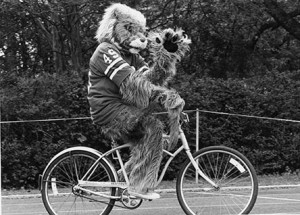
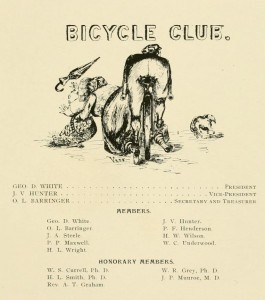
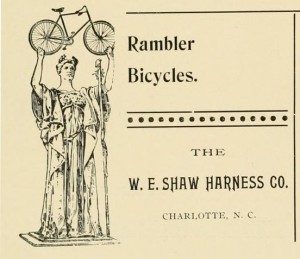
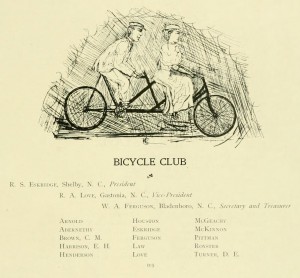
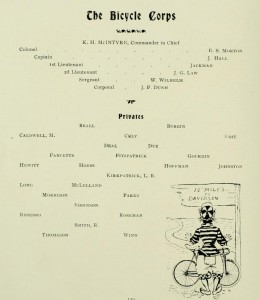

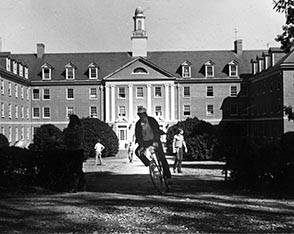

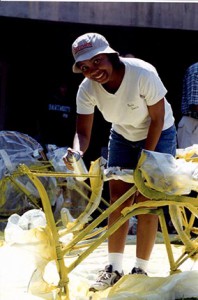
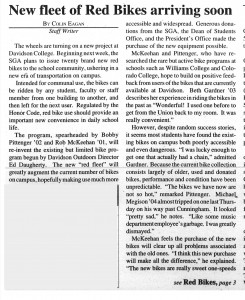
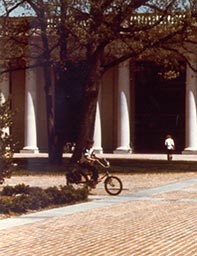

Speak Your Mind